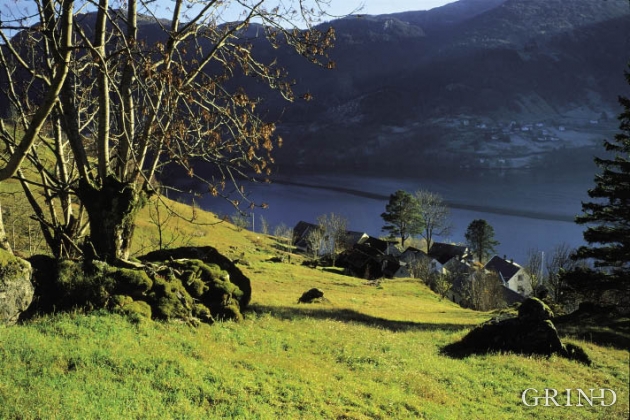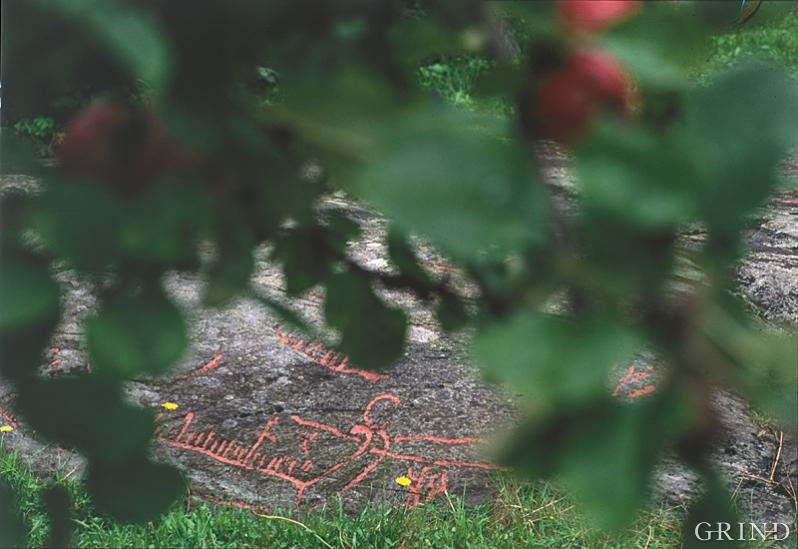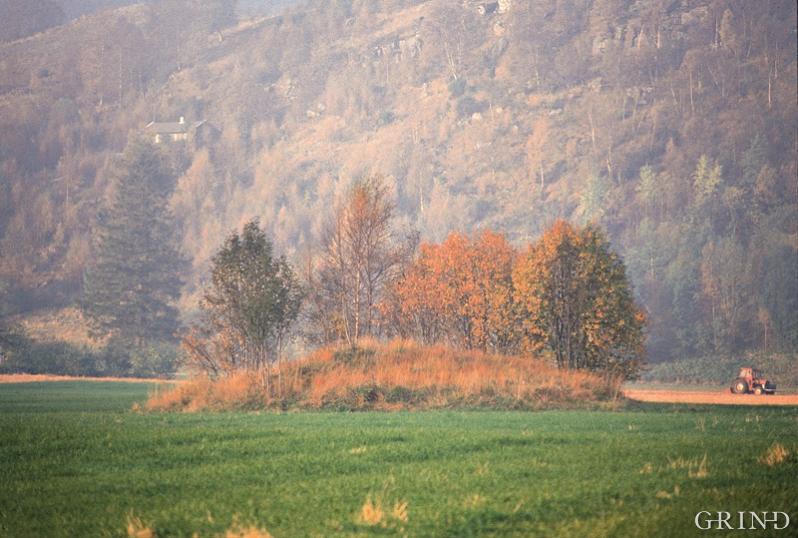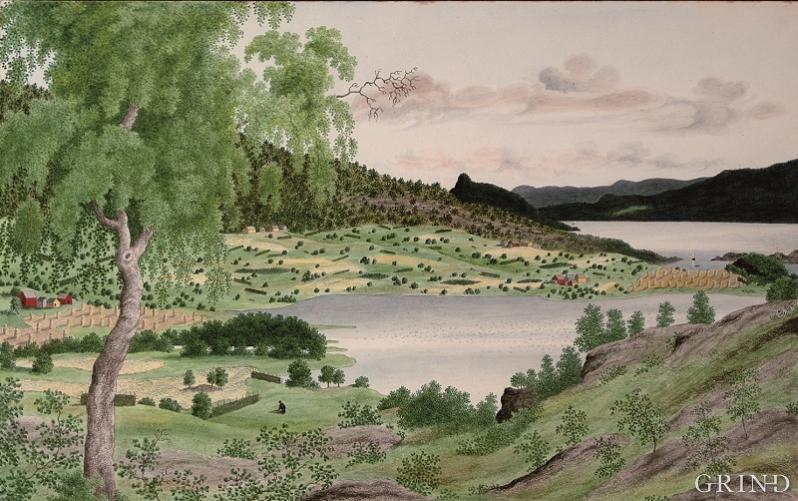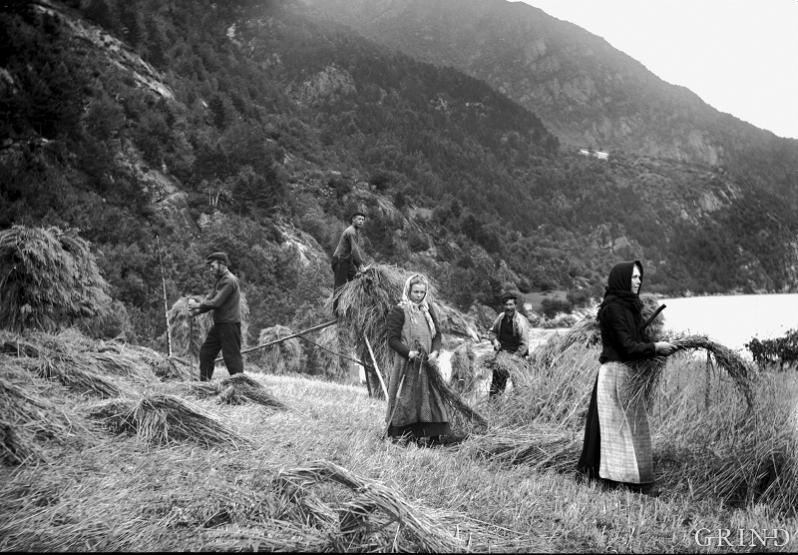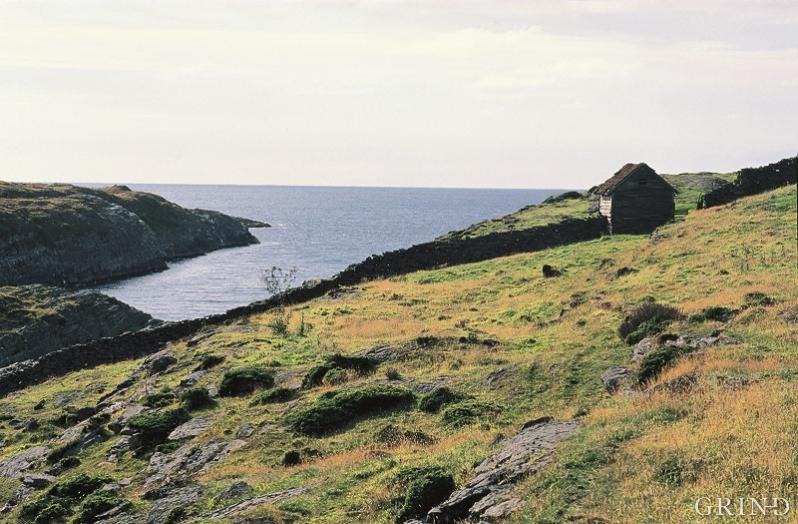Published: 19.05.2009 | Author: Nils Georg Brekke , Svein Indrelid
The steep sloping landscape on Håvra, the dug fields, the piles of cleared stones, the ash poles and the retaining walls tell a rich saga of the cultural landscape (Svein Nord).
The development which culminated in the great west Norwegian clustered communities in the 18th and 19th centuries, such as we see at Havrå on Osterøy Island, actually first came into being in Viking times, with an incipient division of the farms into smaller units. The tool technology which has given form to this landscape, the sickle, the hoe and the wooden plough go just as far back – yes, in fact the sickle and the scythe are tools which have been maintaining and modelling the landscape from the Iron Age.
There are many traces of human acitvity in the cultural landscape
The cultural landscape is rich in content; shaped by generations before us. It is yesterday’s settlement patterns and yesterday’s economic life, which make up today’s cultural monuments. Not every trace in the historical landscape is so easy to discover: ”Is that all there is to see?” is a question, which springs to the lips. But a voyage of discovery in the historical landscape is an exciting experience, which demands knowledge - of Nature, of resources, of settlements and of how people lived. Under the skin, they are not unlike us, those who came before us, but the last 100 years have created bigger changes than in the previous 1,000 years before that.
Today, the expression “cultural landscape” is used in many contexts. We talk of the cultivated agricultural landscape which has been influenced by different ways of working over time, and we talk of cultural monuments within the cultural landscape – the different types of landscape with their characteristic traces of human activity and settlement and we talk of the “immaterial” cultural landscape: the sum total of our knowledge of economic structure, handicraft traditions, social institutions, language, and place names which have shaped the local environment within a particular period of time or a particular geographical area; This also contains what the sociologists call “maps of recognition”; we interpret our physical surroundings on the basis of our knowledge horizon. It brings new qualities to the cultural landscape and fills it with content. It reflects our knowledge of the “canny” society and “skill of our hands”.
The historical landscape
Today a dramatic collapse in historical structures or relations is taking place. We are consuming Nature and the organically developed cultural values to an extent far beyond a reasonable level of subsistence, and much more so than in the past, we are a generation who are turning a page of history.
The cross-section from the coastal regions to the mountain plateaux, one of the most comprehensive landscape regions in Europe, provides us with a picture of many different types of cultural landscape.
The coastal landscape, the outer part of the shore zone is divided up into islands, islets and skerries. Seafaring and small-scale farming are the essential ways of making a living; this is the landscape of the fisherman-farmer. The old trading and guesthouse settlements are also part of a great transport pattern, which have existed since prehistoric times.
The heath landscape is a part of a greater North Atlantic coastal zone. It belongs to the coastal landscape, but extends inwards over the shore zone; the old seabed. Here we come across a style of building influenced by the resource base and by the climate. The heathlands are a cultural landscape which have been cultivated over 2,000 years. The stone architecture in this region is closely related to the building style in the treeless islands on the other side of the North Sea.
The fjord landscape, as we encounter it in Nordhordland, Sunnhordland and Hardanger perhaps provides the most impressive setting to the clustered hamlet, a settlement form which has influenced the cultural landscape in western Norway right up until the middle of the 19th century. One of the most extensive changes in the landscape scene is the dissolution of the old clustered community. This way of working the land, which could be traced back to the Bronze Age, disappeared when the redistribution of land (as part of the great land reforms) got underway towards the end of the 19th century
The hidden saga
The first farmers who burnt the forest and sowed corn in the ashes, left no written trace behind them. What they experienced of joys and sorrows, of day-to-day or dramatic events, went with them to the grave and were forgotten.
Millennia of our oldest sagas are without words. No contemporary written sources can tell us when the oldest farmsteads were cleared, or how hamlets were settled and villages grew up.
But now and then we do come across a relic from these distant times when we can meet them directly and in person, those our nameless forebears who have lain at rest under the turf for many thousand years. They give rise to thoughts, removed in time and space, from a time when a farmer picks up a stone axe in his field, lost by a fellow worker four thousand years before. It could well be that, for a moment, he has a feeling of contact with someone from another time - before the axe was put away and the tractor rolled on to the scene.
If we stop in front of the rock surface at Bakko in Herand, we see images of ships, and human figures and spirals light up in front of us. Three thousand years ago the figures were hewn into the rock with a clear and obvious purpose. The symbols were obvious to the carver and his contemporaries. But the meaning has been forgotten. For us the figures are a remarkable, but incomprehensible greeting from a Bronze Age folk and their way of thinking.
Powerful grave monuments, mounds and ruins still put their stamp on the landscape. Impressive monuments at Byrkjehaugen near Voss or Rimbsvarden near Fitjar had one time a story to tell. Folk who sailed down the Sundnes sound and saw the piles of stones at Halsnøy knew who lay under these lonely heaps of stones and could tell the ancient sagas of mighty deeds and great events. In our times it is the last remnants of a thousand year old monument which can be saved, and no more, when progress makes its presence felt.
Knowledge and values
In our well-informed society there is an elementary truth that knowledge creates values. It is equally important that history creates attitudes to values. Thus history - our knowledge about our cultural heritage - is so important. Not because we want to pride ourselves in our cultural heritage so that we can promote ourselves; saving a monument which we convert to a status symbol for our own way of living, or using historical values only a sort of welfare benefit for use by our own generation. But the value system of the subsistence society has a special message for our own time; the message from the thrifty society, the pleasure of good handiwork, and survival on limited resources. The ecological perspective has had to give way for far too long to the economic perspective. For earlier generations it was a question of survival, for us it is a question of living too well, of over consumption.
There is a paradox that in the post-War period, a period of well-being without parallel in Norwegian history, historical values have vitrified as never before. In our space-loving consumption society we all of us behave more or less like Bør Børsen Jr., Johan Falkberget’s universal portrait of the short-sighted, plebeian upstart.
Taking pleasure and pride in a valuable cultural heritage must not give way to national arrogance. We must never let this happen. And we see more clearly than ever in our time that a combination of nationalism and local chauvinism is a poor mixture.
Thus today we must maintain a good distance from cultural fascism; the use of historical values and monuments as symbols of power or symbols of splendour.
We must beware of an uncritical focussing on the special Norwegian or National Romantic image of our cultural history. A need for identity and “roots” must not take on the character of national self-praise: nor should we dwell unduly on the past and say: “everything was so much better before”.
The resource perspective
It is the resource perspective that should be in the centre of our interpretation of our history, both our day-to-day history and within the political arena. The high resource consumption society should not be given biased priority over a low resource consumption society; high technology should be compared with low technology, to clarify and correct things, growth has its limits. To ignore the ecological long-term perspective when we want to promote sustainable development, will be a dangerous misjudgement. In this case historical understanding and knowledge will be a resource in both senses.
Our history has lengthy links backwards to a national “Golden Age”. The cultural history artefacts in Norway are older than in many countries. The Norwegian wooden house from the Middle Ages and the rock paintings from the Bronze Age are unique, but the ability to survive in a small coastal society constitutes a great national “epos”, although on a somewhat different level. The joined houses in the Bergen area and the well constructed hamlets in the Voss villages are paraphrases for a cultural wholeness, it is a matter of existing and of surviving: of a programme for the good life. We should always be on the lookout for the whole picture, and for relationships in our work with historical source materials, so that the “antiquarian” Norway does not become the “fragmentary” Norway.
We are at a turning point in our cultural history. Handicraft traditions, settlement patterns and building techniques, which have been in use for hundreds of generations are disappearing in our time. The noble art of handicrafts has many themes. Using the upright loom women have woven homespun cloth and wall hangings in the same way from the Viking times to yesterday. In boat building men have mastered the sea and harvested our nearby resources. The Smokehouse , the house with an open fireplace has been our home for a thousand years.
Our cultural heritage- a resource which cannot be renewed
The fact that we hold on to our historical values does not mean to say that we are cut off from all new thinking. Neither should this lead to a falsification of historical fact: we profile and prettify our cultural history to make the product easy to sell. And here the tourism business must take very great care. It is all of our duty to contribute to a process that evaluates our values and not devalues them.
We must not offer for sale our own culture in such gaudy colours and such cheap editions that we become as hot and flushed as the trolls the tourist industry mass-produces. Neither must we, in a short-sighted and misconstrued eagerness to make our history visible, fall for the temptation to surround ourselves with historical copies which reek of heavy nationalism or uncritical regionalism; each village and each municipality will, as best it can, sugar its own bit of history
History all around us
History is not just history for experts. History is a day-to-day quality for us; a dimension in our existence. Historical values create qualities in today’s and tomorrow’s society, they create attitudes and they create meaning. Thus traces of our history can be found in the landscape and within our local area. Thus our generation must exhibit the greatest care and attention for the cultural monuments in the landscape. They cannot be renewed. On behalf of coming generations society must be willing to allocate sizeable amounts of money to the conservation of culture and the environment. If conservation does not cost anything then we can hardly speak about values. We are the guardians of great values. The history of our cultural heritage lies within our local societies. That is what this book is about.
- Brekke, N. G. (1987) Byggeskikk og kulturlandskap. Fortidsvern, 1987 (3), s. 7-11.
- Brekke, N. G. (1990) Kriteriegrunnlaget i kulturminnevernet. I: Kulturminnevernets teori og metode. Oslo, Rådet for humanistisk forskning, Norges allmennvitenskapelige forskningsråd, s. 182-193.
- Jansson, S. (1974) Kulturvård och samhällsendring. Lund.

